Rome, or the Eternal City, is the capital and the centre of history, art and architecture in Italy. The city on the Tiber River was the ancient capital of the mighty Roman Empire, which left a legacy of impressive ancient Roman landmarks that still stand today. Founded in 753 BC, the city is one of the oldest cities in Europe that has been continuously occupied and is one of the birthplaces of Western civilisation. As a major centre of the Italian Renaissance and birthplace of Baroque style, it’s no wonder there’s a treasure trove of landmarks in Rome. The only trouble you will have is choosing which ones to see, so start by ticking these Rome landmarks off your bucket list.
Contents
- Rome Landmarks
- Top Tours
- Famous Landmarks In Rome
- 1- The Colosseum
- 2- The Pantheon
- 3- The Trevi Fountain
- 4- St. Peter’s Basilica
- 5- The Sistine Chapel
- 6- The Roman Forum
- 7- Piazza di Spagna (Square of Spain) and the Spanish Steps
- 8- Trajan’s Market
- 9- The Domus Aurea
- 10- Villa Doria Pamphili
- 11- Theatre of Marcellus
- 12- Museum of Ara Pacis
- 13- The Mouth of Truth
- 14- Via del Corso
- 15- The ‘Pincio’ panoramic viewpoint
- 16- Via Condotti
- 17- Tiber Island
- 18- Testaccio Market
- 19- Orange Trees Garden
- 20- The Ancient Appian Way
Rome Landmarks
Top Tours
- Rome: Colosseum, Palatine Hill and Roman Forum Tour – see the top three Roman landmarks with a guide.
- Rome: Trevi Fountain, Spanish Steps and Pantheon – three more landmarks in Rome you won’t want to miss.
- Roma Pass: 48-Hour City Card – save money with transportation included.
Famous Landmarks In Rome
1- The Colosseum
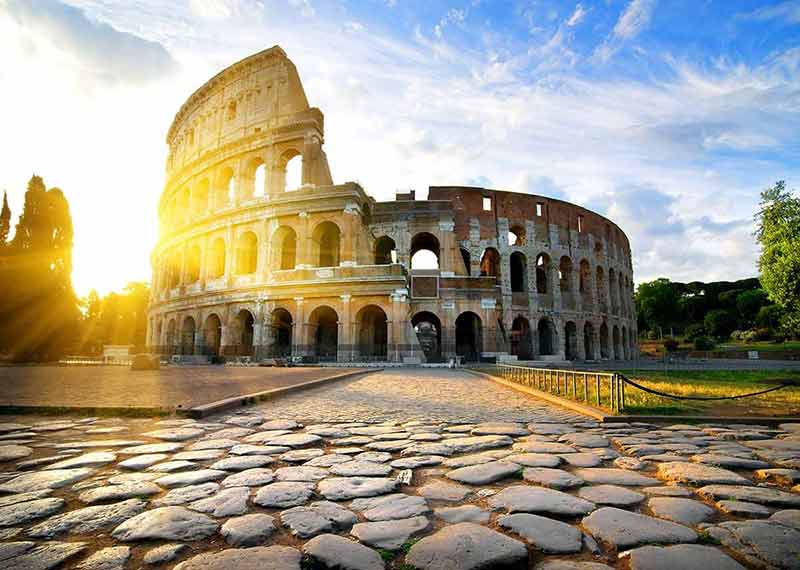
The Colosseum, or Anfiteatro Flavio, is the most famous landmark in Rome and the city’s most popular attraction.
It’s probably the first thing that comes to mind when thinking about the capital of Italy.
This Roman landmark is 1,900 years old, built during the reign of Vespasian and is the most prominent ancient arena in the world.
The Colosseum was used for gladiator shows, animal hunts, magic shows and simulated sea battles during Roman times.
It’s open to visitors and it’s worth taking one of the guided tours.
For the best Colosseum experience, schedule your visit early in the morning, away from the big crowds.
2- The Pantheon
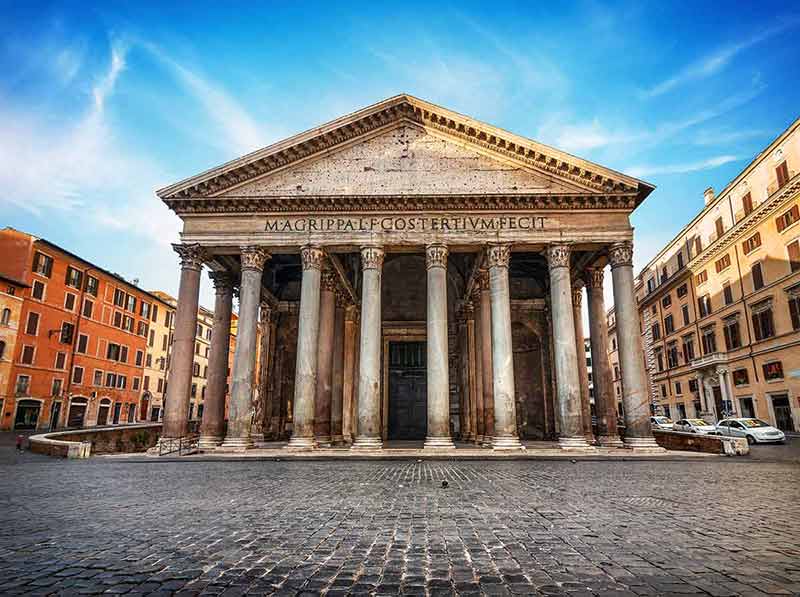
The Pantheon, now a catholic church called Basilica di Santa Maria, was once a Roman Temple designed following the ancient Greek temple style.
The name itself, Pantheon, comes from ancient Greek and can be translated as “(temple) of all the gods”.
An outstanding feature of this landmark in Rome is its majestic portico composed of 16 granite Corinthian columns.
Entering the Pantheon is a truly unique experience: while the outside says “Greek temple”, the inside has a distinct Italian Renaissance feel, with the walls covered in beautiful 15th-century frescos.
The dome holds the record as the largest dome in the world made of unreinforced concrete.
You can find the characteristic oculus at the centre of the dome, a hole in the dome of 9 m in diameter, designed to allow light to filter through, creating an enchanting spectacle of light and shadows.
3- The Trevi Fountain
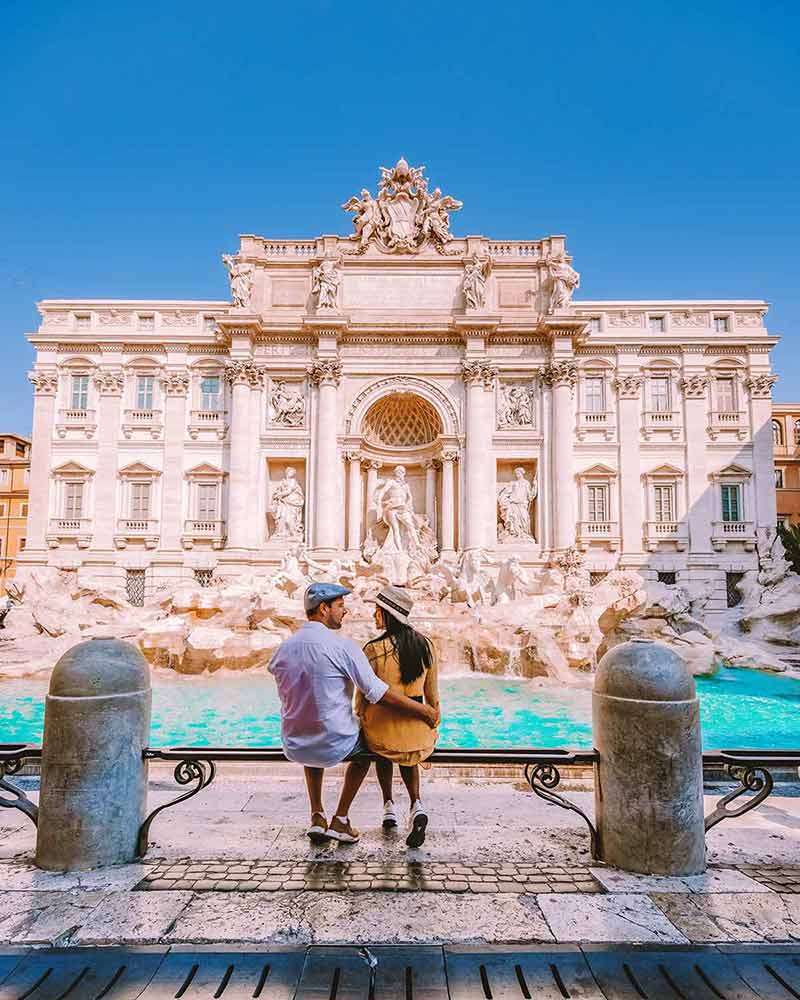
You’ve seen it in Roman Holiday, you’ve loved it in Fellini’s La Dolce Vita.
Featured in movies and music videos, the Trevi fountain is one of the most iconic fountains in the world.
The fountain was built in the 18th-century and designed by Nicola Salvi.
The theme of the Trevi Fountain is the Sea, with grand triumphal arcs and statues of mythical characters such as Oceanus, Abundance and Salubrity.
A composition of tritons and horses are the protagonists of the fountain’s scenography.
Admire the Trevi Fountain, and don’t miss out on local traditions.
It is an old belief that tossing a coin in the fountain with your eyes closed and your back facing Palazzo Poli will guarantee that you’ll be back in Rome once more.
4- St. Peter’s Basilica

Vatican City, the autonomous state and Pope’s residence built within Rome, is also home to St. Peter’s Basilica.
The Basilica was designed by some of the most notorious Italian Renaissance artists such as Donato Bramante, Michelangelo, Carlo Maderno, and Gian Lorenzo Bernini and is the largest Catholic church in the world!
Among the many works of art, while visiting the chapels and walking the corridors that weave through the Basilica, you will be able to admire the famed Michelangelo’s Pieta (La Pietá) as well as the tombs of the Popes in the Vatican’s grottos, and even the tomb of Saint Peter.
Book a tour of the Vatican, Sistine Chapel and St. Peter’s Basilica here.
5- The Sistine Chapel

You cannot walk past the Sistine Chapel (Cappella Sistina) when visiting the Vatican’s museums without looking inside.
From the outside, the building appears austere, simple and unadorned but on the inside, it’s one of the most elaborately decorated chapels in the city.
The ceiling illustrates “The Last Judgment”, the history of the Second Coming of Christ and the final judgment by God on humanity frescoed during the 16th century by Michelangelo.
The chapel is over 13 m wide, 40 m long, and almost 21 m high, with walls and ceiling entirely frescoed by the best Italian Renaissance artists.
For more amazing European Landmarks, read:
- 30 Spain Landmarks
- 20 Switzerland Landmarks
- 22 Germany Landmarks
- 35 London Landmarks
- 30 France Landmarks
- 20 Italy Landmarks
- 20 Greece Landmarks
- 20 Russia Landmarks
- 20 Scotland Landmarks
- 20 Ireland Landmarks
- 21 Wales Landmarks
- 20 Turkey Landmarks
- 20 England Landmarks
- 20 Hungary Landmarks
- 21 Romania Landmarks
- 20 Ukraine Landmarks
- 20 Athens Landmarks
- 20 Rome Landmarks
- 20 England Landmarks
- 20 Portugal Landmarks
- 20 Poland Landmarks
- 20 Iceland Landmarks
- 20 Bulgaria Landmarks
- 21 Croatia Landmarks
- 20 Bulgaria Landmarks
- 20 Austria Landmarks
- 21 Finland Landmarks
- 20 Sweden Landmarks
- 20 Denmark Landmarks
- 20 Belgium Landmarks
- 20 Netherlands Landmarks
- 20 Barcelona Landmarks
- 21 Czech Republic Landmarks
- 20 Landmarks in Paris
- 20 Landmarks in Liverpool
- 10 Istanbul Landmarks
6- The Roman Forum
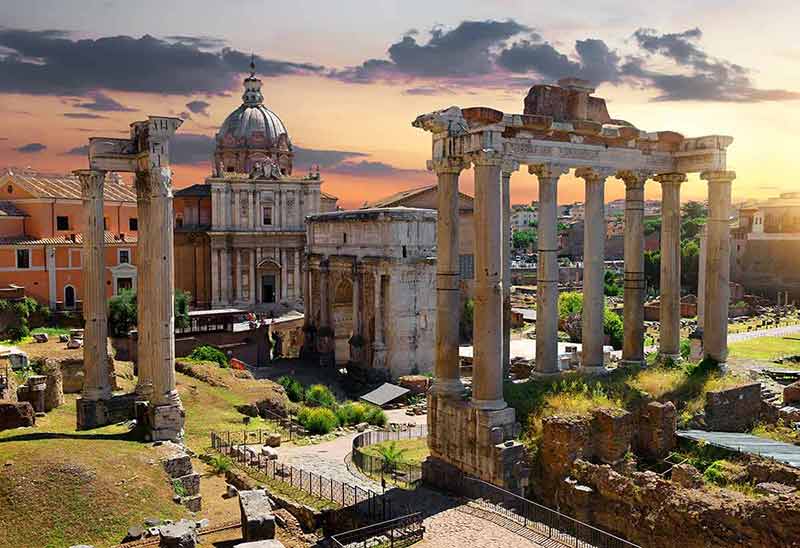
In ancient Rome, the Forum was the city’s heart, hosting the buildings designated for entertainment, justice, commerce and public administration.
Today, the ruins of the ancient Forum are open to visitors, offering the unique opportunity of walking the same roads that all the greats – Caesar, Cicero, August and many more – walked.
This historical site itself represents a small city within Rome and visiting it might take several hours.
Be sure to schedule your visit being mindful of the weather and remember to dress comfortably.
Recommended tours:
- Borghese Gallery Masterpieces & Gardens: Skip-the-Line Tour
- Rome: Exclusive Walking Tour of Classics
- Rome: Street Food Tour with Local Guide
7- Piazza di Spagna (Square of Spain) and the Spanish Steps
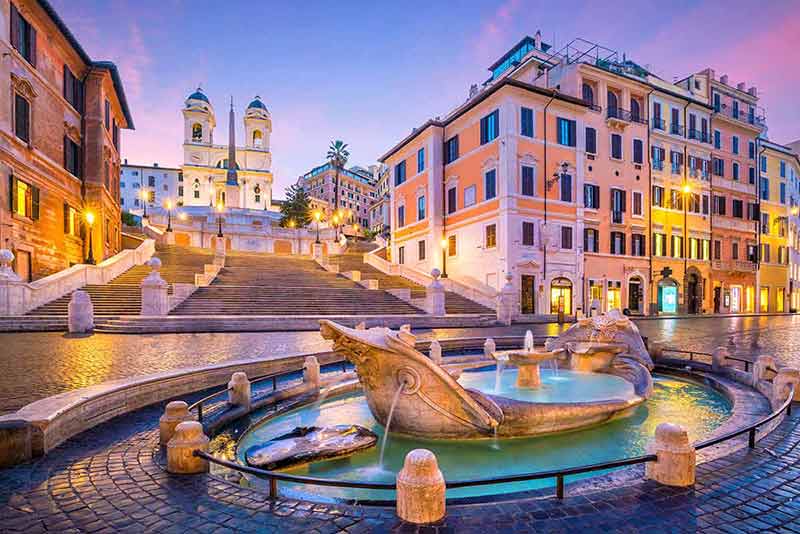
Piazza di Spagna, named after the historical Spanish Embassy, is one of Rome’s most iconic piazze (squares).
The square has always attracted visitors and writers, painters and sculptures from all over the world.
It’s mostly known for its fountain, sculpted by artist Gian Lorenzo Bernini and his father, and the majestic Spanish Steps.
The Spanish Steps were inaugurated in 1725 to connect the square with the church of Trinità Dei Monti.
This monumental stairway counts 135 steps and is one of the most beloved spots in the city to grab Italian homemade ice cream, have a quick drink, or opt for a high-class tea in one of the tea houses of Piazza di Spagna.
8- Trajan’s Market
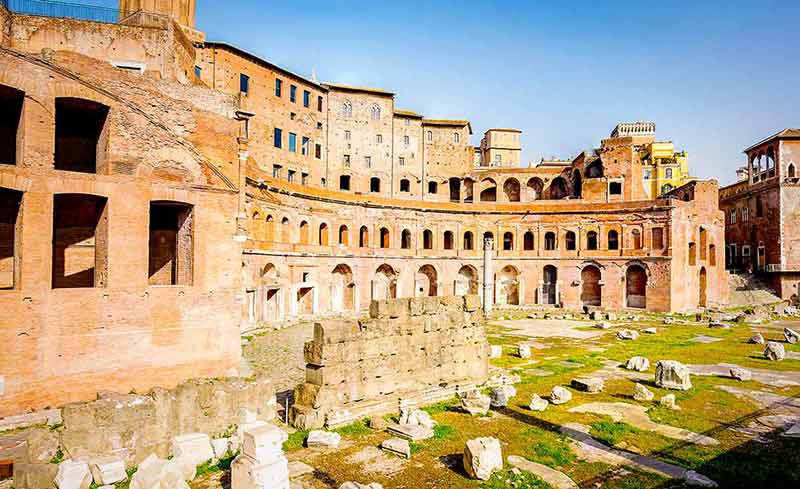
Another historical site from ancient Rome worth visiting is Trajan’s Market.
The market was designed and built between 100 and 110 AD by the Apollodorus of Damascus, a loyal friend of Trajan who always followed him in his ventures.
Trajan’s Market has always been a place of multiple purposes, with its lower part an extension of the Forum and its upper part used to house management and administration offices.
Today it is possible to enter and visit the different levels of Trajan’s Market.
9- The Domus Aurea
Nero’s Domus Aurea, the infamous emperor’s Golden House, was built around 64 AD on over 80 ha and featured a small neighbourhood of streets, avenues, gardens, baths and fountains.
The name Domus Aurea comes from its luxurious and opulent style, as the district was adorned with gold and precious stones.
Unfortunately, the precious materials were lost over time, but you can still visit the pavilions and buildings of Domus Aurea.
10- Villa Doria Pamphili
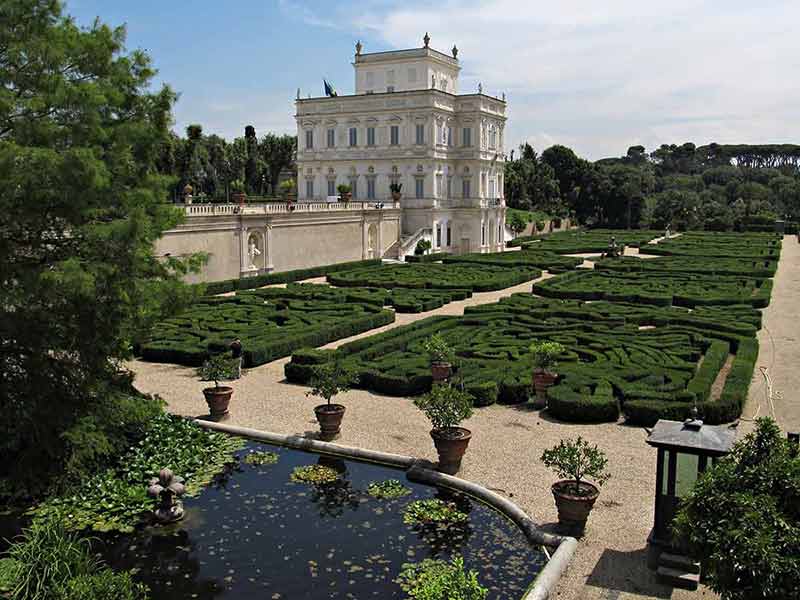
The historical Villa Doria Pamphili is mainly known for hosting the largest park in Rome, around 184 ha outside the city walls and the Doria Pamphili Art Gallery.
The garden is crossed by a watercourse that ends in an exquisite lake with an island in the middle.
Thanks to its great biological variety, the garden of Villa Doria Pamphili is also a preferred location in the city for bird watchers.
With its 18th-century feel, the Art Gallery features different sections, all worth visiting: the Mirror Gallery, the Aldobrandini Gallery, the Doria Gallery, and the Pamphili Gallery.
11- Theatre of Marcellus
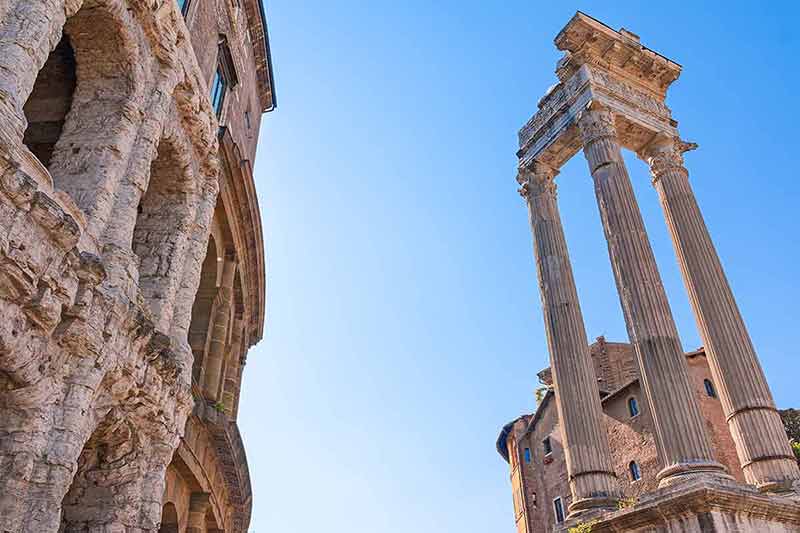
The Theatre of Marcellus is one of the best-preserved ancient theatres in Italy, and its monumental size (130 m in diameter) makes it a truly unmissable landmark of Rome.
Inaugurated in 13 BC, the theatre was a blueprint for the design of the Colosseum.
On the outside, the Theather of Marcellus features two monumental orders of Ionic and Doric arches, and on the inside, it used to host over 15 thousand spectators.
The archeological area hosts two ancient Roman temples, the Temple of Apollo and the Temple of Bellona.
12- Museum of Ara Pacis
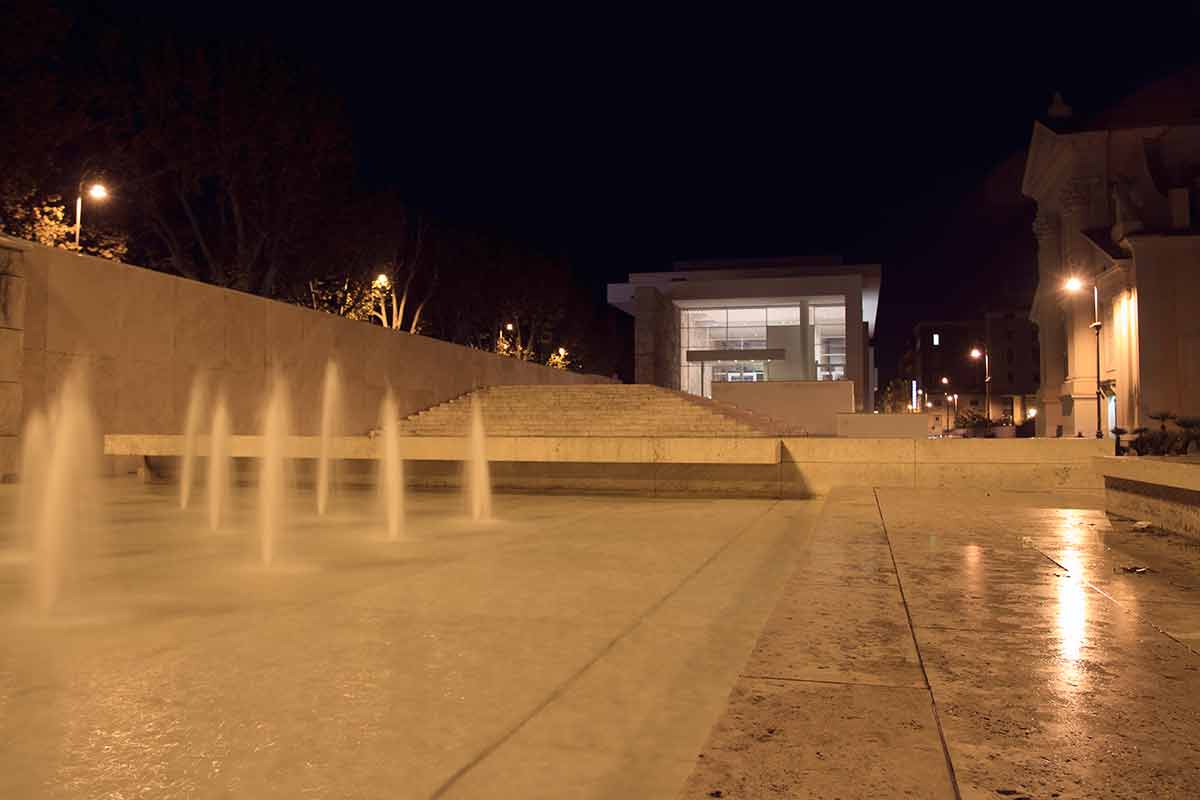
Ara Pacis Augustae, or Ara Pacis shortened, is a monumental altar dedicated to the goddess of Peace, Pax.
It was sculpted in 13 BC to celebrate and glorify Augustus’ return to Rome after the war in Spain and Gaul.
Originally, the Ara Pacis was located in the Campus Martius, however, it was restored in the 20th century and moved in 1938 to the Museum of Ara Pacis.
The museum is designed to protect the altar from pollution and rain damage.
The space of the Museum of Ara Pacis was designed by the American architect Richard Meier and has a clean, modern look.
13- The Mouth of Truth
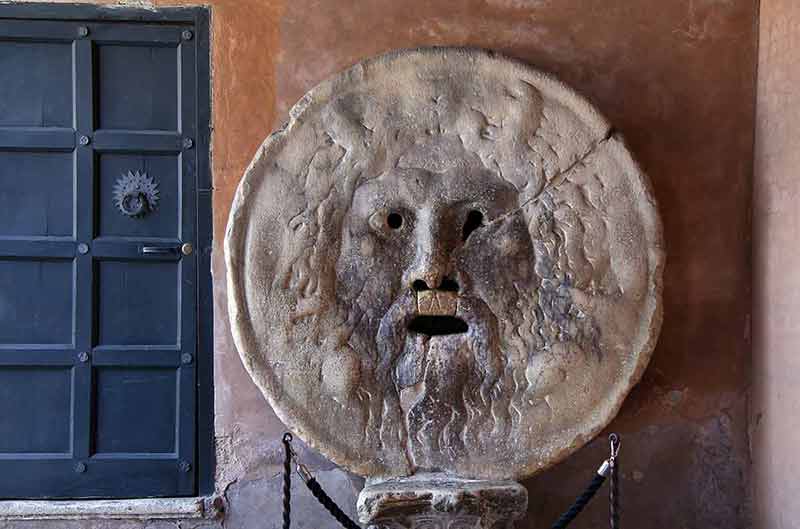
The Mouth of Truth is an ancient marble mask, now walled into the church of Santa Maria in Cosmedin.
The mask represents a bearded male face with hollow eyes, nose and mouth.
Originally, the Mouth of Truth was a manhole, as maintenance holes were designed to resemble river deities swallowing the rainwater during those times.
The mask has always been surrounded by mystery and is believed to have the power to pronounce oracles.
Today, it is a common belief that if you put your hand in the Mouth of Truth, you cannot lie.
In fact, according to ancient Roman folklore, anyone lying would immediately lose their hand.
This is, of course, a legend, but it’s still a thrilling experience to place your hand in the marble Mouth.
14- Via del Corso
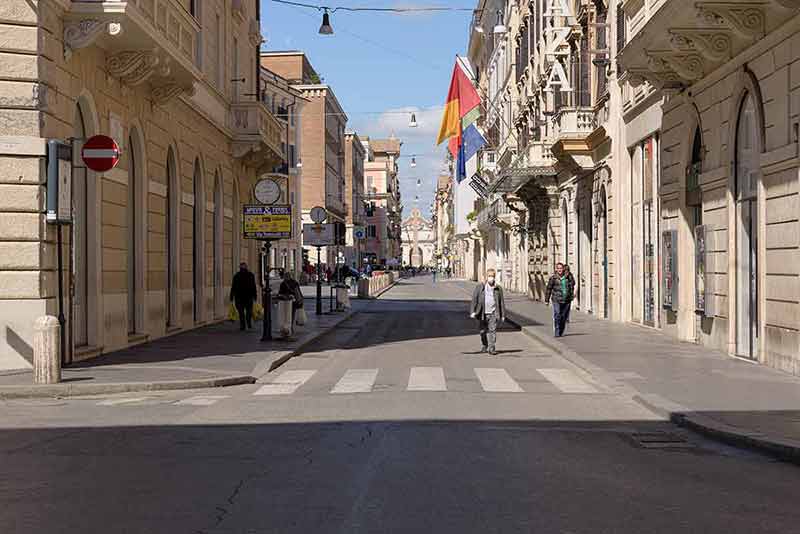
Via del Corso is Rome’s main street in the city centre.
It runs from Piazza Venezia to Piazza del Popolo and is known for its many low-end stores and high-end boutiques located on the avenue.
For the shopping lovers out there: you could spend days shopping on Via del Corso but the street also hosts many must-see landmarks in Rome.
They include the baroque churches of Santa Maria del Miracoli and Santa Maria in Montesanto, Piazza Colonna and the historical column of Marcus Aurelius, Santa Maria in Via Lata, and the Palazzo Doria Pamphili.
15- The ‘Pincio’ panoramic viewpoint
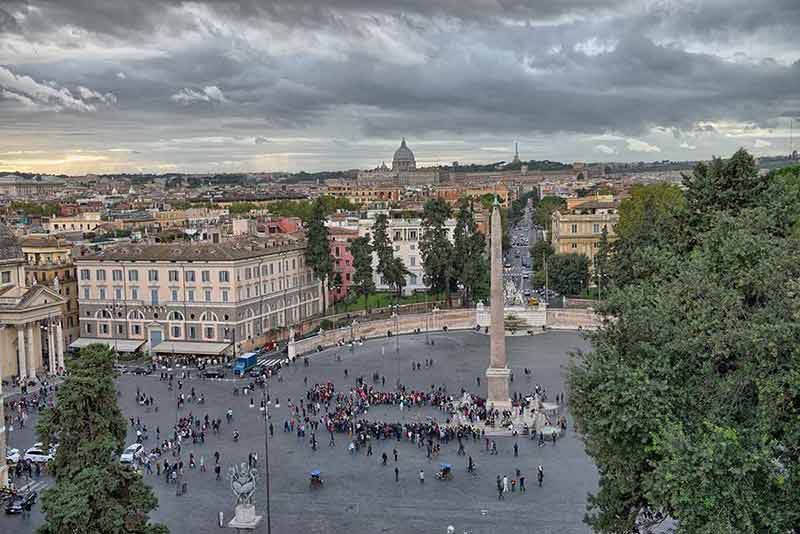
Pincian Hill is one of the most stunning viewpoints in Rome, and the view from this 61 m-high hill is spectacular at sunset when the sky over the city slowly turns pink.
The hill overlooks Piazza del Popolo, but on a cloudless day, you can admire the dome of St. Peter’s.
If you’re looking for an alternative date-idea, the park itself is lovely and a perfect location for a romantic picnic surrounded by nature, fountains and paths.
16- Via Condotti
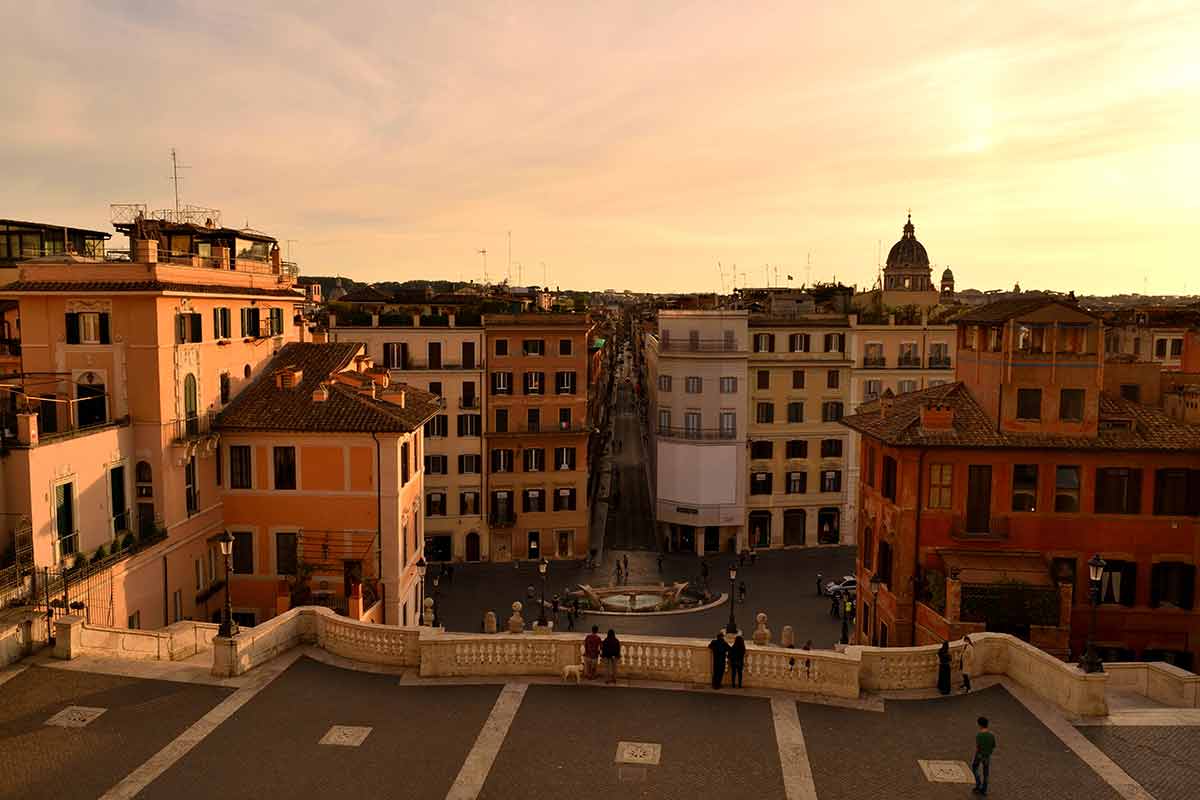
Via Condotti is one of the main avenues in Rome, and despite its clear historical and architectural value, it is mostly known as the go-to spot for those looking for high-end shopping.
Among the many luxurious choices, in Via Condotti, you’ll find the ateliers of Dior, Gucci, Valentino, Jimmy Choo, Prada, Céline, Dolce & Gabbana, Tiffany & Co. and Louis Vuitton.
As for the historical landmarks, the most notables are the 18th-century church Santissima Trinità, the 19th-century building Palazzo Della Porta Negroni Caffarelli, the Palazzo di Malta and the oldest cafè in Rome, the Antico Caffè Greco.
Recommended tours:
- Rome: City Center Highlights Tour by Quality E-Bike
- Rome: Big Bus Hop-on Hop-off Sightseeing Tour
- Rome: Under the Moonlight Evening Walking Tour
17- Tiber Island
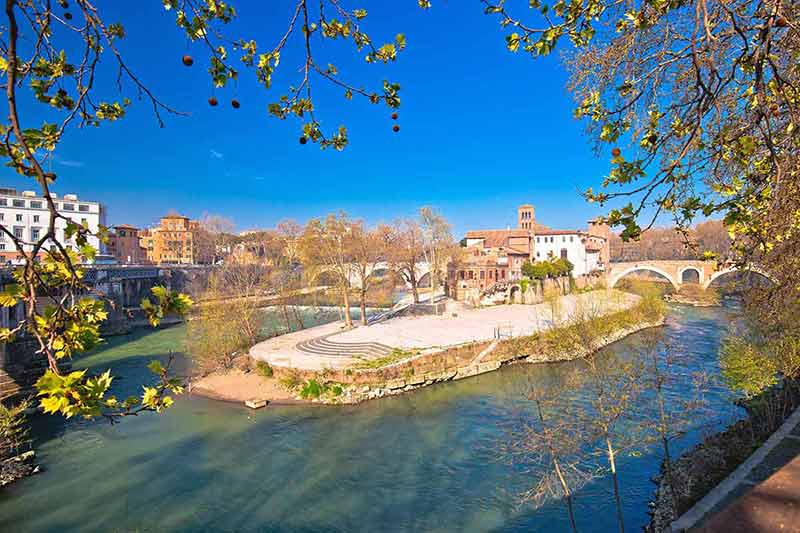
The sacred Tiber Island, or Isola Tiberina, was initially formed by the accumulation of volcanic rocks and deposits from the river.
The island was consecrated to the Greek god of medicine and healing, Aesculapius, and to this day, this holy place is considered a place of healing.
The hospital run by the Hospitaller Order of St. John of God is still open and active.
Tiber Island is a relaxing spot in Rome for both locals and visitors, a true green oasis in the heart of Italy’s capital to enjoy a moment of quiet with a stunning view.
18- Testaccio Market
Testaccio Market is a historical and characteristic local market of Rome.
For the foodies reading this guide, Testaccio Market will not disappoint you.
It’s a fresh food market that also offers a gastronomical experience, with market stalls selling Italian food and wine that may be difficult to find anywhere else.
It’s a great place to shop for the week or to have a quick and super tasty lunch.
Make a reservation to visit the archeological area and join an archeologist-led guided tour.
19- Orange Trees Garden
The charming and unique Orange Trees Garden, or Giardino Degli Aranci, takes its name from the bitter orange trees planted there hundreds of years ago.
The Orange Trees Garden offers an excellent overview of Rome’s skyline and the Tiber River.
The climb to get to the garden without a car is steep but worth it.
The orange trees, combined with the view and the live Italian music often playing in the background, create an unmatchable atmosphere that you will hardly forget.
The Orange Trees Garden is also one of the best spots in the city to take in beautiful pictures.
20- The Ancient Appian Way
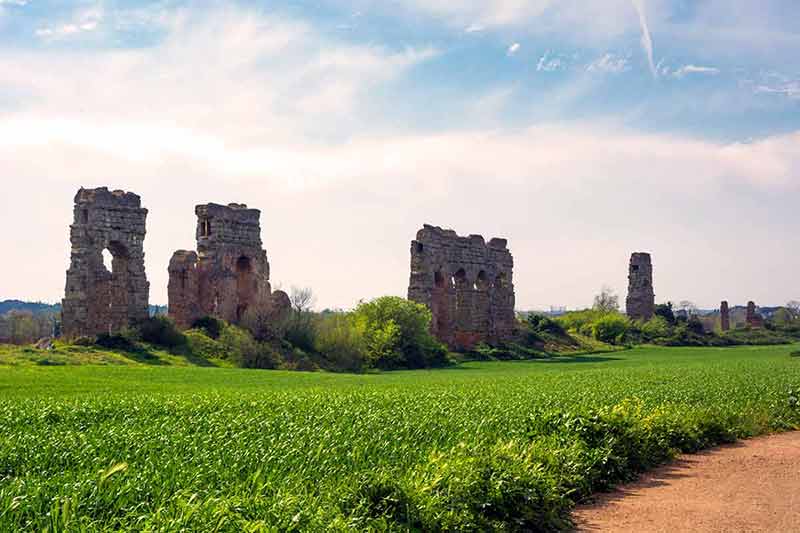
The Appian Way is one of the first-ever Roman roads to be built, and it strategically connected Rome to Brindisi.
Walking this 2000-year-old road will take you back to Ancient Rome, connecting you with all of the merchants, soldiers, and travellers that walked those stones before you.
The Ancient Appian Way is peaceful and surrounded by nature, offering a well-deserved break from the chaotic streets of Rome.
Sacred burial places and inscribed catacombs surround the Ancient Appian Way, making this an excellent spot for those longing for a spiritual and moving experience.
Looking for more things to do in Italy? Here are some places you will love!
- 20 Landmarks in Italy
- 20 Best Beaches In Italy
- 20 Places To Visit In Italy In Winter
- 20 Incredible Things To Do In Lake Como
- 15 Things To Do In Rome At Night
- 21 Things To Do In Turin
- 15 Things To Do In Venice
- 20 Italian Drinks And Cocktails
- 24 Best Beaches In Sicily
- 20 Venice Night Attractions
- 20 Things To Do In Milan At Night
- 20 Things To Do In Florence At Night
- 20 Things To Do In Sicily
- Venice in Winter
- 20 Fairytale Castles In Italy
- 15 Italian Movies On Netflix
- 15 Italian Shows On Netflix
- 6 Charming Towns in Puglia
- Sacro Monti di Varallo
- Hiking Stromboli
- Salone del Gusto – Slow Food Festival
- 20 Things To Do In Florence
- 20 Beaches In Malta
- When Is The Best Time To Visit Italy?
- 20 Italian Cities
- 20 Things To Do In Pisa
- 20 Things To Do In Pompeii
- Where To Stay In Venice
- Where To Stay In Cinque Terre
Plan Your Trip

Rent A Car – Find the best car rental rates at Discover Cars. They compare car hire companies to provide you with the best deal right now.

Find A Hotel – If you’re curious about this article and are looking for somewhere to stay, take a look at these amazing hotels.

